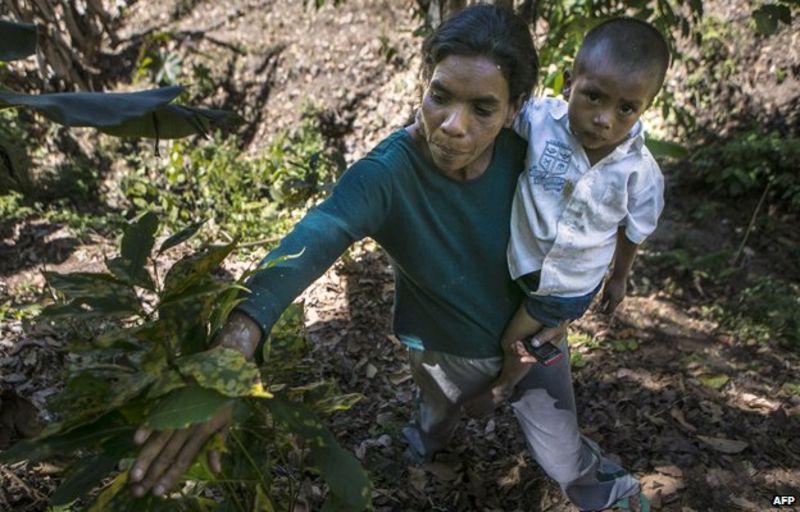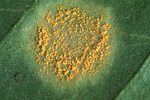What is rust caused by? How to deal with the harm of iron rust to coffee beans
Coffee rust, also called coffee leaf rust. Coffee rust is the most important coffee disease in the world economy. In terms of monetary value, coffee is the most important agricultural product in international trade.
It is a destructive foliar disease. The coffee plant Lobelia involucrata caused by fungi. As early as in the coffee-growing areas of Africa, the near East, India, Asia and Australasia, coffee rust was found to be widespread in Brazil in 1970, the first known infection area in the Western Hemisphere. In the late 1800s, coffee rust destroyed once prosperous coffee plantations in Sri Lanka and Java, and epidemics in Central America and the Caribbean have destroyed many plantations in the region since 2012.
Symptoms of coffee rust include small, yellow, oily spots on the upper surface of the leaves, which expand into larger round spots that change from bright orange to red and finally to brown with a yellow border. The rusty pustules on the lower surface of the leaves are powdery and orange. Then the pustule turned black. The rusty leaves fell and the affected trees were almost stripped off; these trees produced significantly less coffee and usually died within a few years.
Coffee rust can be partially controlled by spraying fungicides in time during the rainy season. Plantations in some areas have moved to higher, cooler elevations, that is, 1800 to 2100 metres (6000 to 7000 feet), where rust is difficult to reproduce, but global warming is expected to further spread the disease to these areas. There is evidence that shade-grown coffee, which is not under single cultivation, is less vulnerable because agroforestry practices of mixed tree crops have greatly slowed the spread of the disease. In addition, resistant varieties of robusta coffee (Coffea canefora) have been developed, but it is generally believed that the quality of these beans is lower than that of vulnerable Arabica plants (C. arabica). A disease-resistant variety, Lempira, was widely planted in Honduras, but lost resistance to the disease in 2017, resulting in the loss of crops in the country. No resistant varieties were shown to be unaffected by all fungal species.

Coffee rust must be managed as a persistent epidemic on perennial crops, so any factor that can reduce spore formation, spore transmission or infection, even in small amounts, can alleviate the epidemic. Good cultural management is the most important, but there are no simple rules to follow. The variety planted, the characteristics of the soil, rainfall and distribution, and many other factors interact to determine what is needed. One of the key cultural management decisions is to produce coffee in plenty of sunlight or in a certain degree of shade (figure 11). This is usually more like a sociopolitical decision than an agronomic decision. Some people say that in plenty of sunlight, properly spaced plants are more likely to control rust because they dry faster, so their leaves are moist for less time. (they are also easier to spray fungicides. Others believe that coffee grown in shade is less rusty because the closed canopy of shade trees prevents dew from forming on coffee leaves, thereby reducing infection. However, dew usually does not last long enough to support infection. Due to reduced yields, shading is more likely to reduce the sensitivity of plants to rust; the production of heavy crops depletes the nutrients of trees, making them more vulnerable to infection. In general, sun-grown coffee is produced on large, well-capitalized farms that can control rust with fungicides, whose costs are offset by higher benefits. Small "low-tech" producers tend to prefer shade-grown coffee, which, despite lower yields, requires less external input in the form of pesticides and fertilizers. They often plant a variety of shade trees to provide fruit, firewood and wood to meet their needs. Some shade trees have nitrogen fixing agents, which can reduce the demand for nitrogen fertilizer. Multi-layer canopy can intercept and slow down rain, reduce runoff and subsequent soil erosion. Structural diversity provides better habitats for birds, mammals, reptiles, insects and many other species, and the impact of these shelters on migratory bird migration routes extends far beyond the coffee farm itself.

As the susceptibility of plants is significantly affected by their nutritional status the consumption of nutrients due to high yield in a particular season will increase the severity of rust not only in that season but also in subsequent years unless nutrients are properly adjusted. Fertilization with nitrogen (N) and phosphorus (P) tends to reduce the susceptibility to rust, but excessive potassium (K) increases the susceptibility. In general, the use of micronutrients reduces susceptibility. Since their effects can be felt in several seasons, such adjustments must be made carefully.
Proper pruning and training of coffee trees can help prevent overplanting and maintain plant vitality, thereby reducing their sensitivity to rust. These also help improve ventilation, promote rapid drying of leaves, and promote spraying by opening the canopy. Wider row spacing can reduce planting density and improve air circulation and spray coverage.
Coffee is very sensitive to weed competition, so good weed control is very important to maintain plant vitality and thus reduce sensitivity to rust. Good weed control also helps to promote air circulation and rapid drying of the crown.
Important Notice :
前街咖啡 FrontStreet Coffee has moved to new addredd:
FrontStreet Coffee Address: 315,Donghua East Road,GuangZhou
Tel:020 38364473
- Prev

Coffee Grinder Beginner's Guide to Grinding Coffee By-Products Electrostatic Coffee Bean Grinding Coarse Effects
Coffee is a violent thing. Coffee is taken from its friendly home, in bags or jars, and put into bean hoppers, which in itself is not a bad place. But when the grinder is turned on, as soon as the coffee begins to grind into small particles, you immediately hear the sound of the motor and the sound of the burr spinning wildly. This is where the action takes place and where your coffee experience begins.
- Next

Flavor and taste characteristics of Indonesian coffee beans in addition to Java coffee in Sumatra Aceh
Although the Indonesian island of Java has become famous in the coffee industry, Arabica coffee production in Sumatra began only under Dutch colonial rule in the 1700s. Aceh, located at the northern end of the island around Lake Tawar, was the first area to start growing coffee and is known for its complex characteristics of fruit, soil and wood, mainly from their traditional name gilling.
Related
- Detailed explanation of Jadeite planting Land in Panamanian Jadeite Manor introduction to the grading system of Jadeite competitive bidding, Red bid, Green bid and Rose Summer
- Story of Coffee planting in Brenka region of Costa Rica Stonehenge Manor anaerobic heavy honey treatment of flavor mouth
- What's on the barrel of Blue Mountain Coffee beans?
- Can American coffee also pull flowers? How to use hot American style to pull out a good-looking pattern?
- Can you make a cold extract with coffee beans? What is the right proportion for cold-extracted coffee formula?
- Indonesian PWN Gold Mandrine Coffee Origin Features Flavor How to Chong? Mandolin coffee is American.
- A brief introduction to the flavor characteristics of Brazilian yellow bourbon coffee beans
- What is the effect of different water quality on the flavor of cold-extracted coffee? What kind of water is best for brewing coffee?
- Why do you think of Rose Summer whenever you mention Panamanian coffee?
- Introduction to the characteristics of authentic blue mountain coffee bean producing areas? What is the CIB Coffee Authority in Jamaica?

